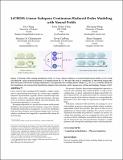LiCROM: Linear-Subspace Continuous Reduced Order Modeling with Neural Fields
Author(s)
Chang, Yue; Chen, Peter Yichen; Wang, Zhecheng; Chiaramonte, Maurizio M.; Carlberg, Kevin; Grinspun, Eitan; ... Show more Show less
Download3610548.3618158.pdf (11.70Mb)
Publisher Policy
Publisher Policy
Article is made available in accordance with the publisher's policy and may be subject to US copyright law. Please refer to the publisher's site for terms of use.
Terms of use
Metadata
Show full item recordAbstract
Linear reduced-order modeling (ROM) simplifies complex simulations by approximating the behavior of a system using a simplified kinematic representation. Typically, ROM is trained on input simulations created with a specific spatial discretization, and then serves to accelerate simulations with the same discretization. This discretization-dependence is restrictive.
Becoming independent of a specific discretization would provide flexibility to mix and match mesh resolutions, connectivity, and type (tetrahedral, hexahedral) in training data; to accelerate simulations with novel discretizations unseen during training; and to accelerate adaptive simulations that temporally or parametrically change the discretization.
We present a flexible, discretization-independent approach to reduced-order modeling. Like traditional ROM, we represent the configuration as a linear combination of displacement fields. Unlike traditional ROM, our displacement fields are continuous maps from every point on the reference domain to a corresponding displacement vector; these maps are represented as implicit neural fields.
With linear continuous ROM (LiCROM), our training set can include multiple geometries undergoing multiple loading conditions, independent of their discretization. This opens the door to novel applications of reduced order modeling. We can now accelerate simulations that modify the geometry at runtime, for instance via cutting, hole punching, and even swapping the entire mesh. We can also accelerate simulations of geometries unseen during training. We demonstrate one-shot generalization, training on a single geometry and subsequently simulating various unseen geometries.
Date issued
2023-12-10Department
Massachusetts Institute of Technology. Computer Science and Artificial Intelligence LaboratoryPublisher
ACM|SIGGRAPH Asia 2023 Conference Papers
Citation
Chang, Yue, Chen, Peter Yichen, Wang, Zhecheng, Chiaramonte, Maurizio M., Carlberg, Kevin et al. 2023. "LiCROM: Linear-Subspace Continuous Reduced Order Modeling with Neural Fields."
Version: Final published version
ISBN
979-8-4007-0315-7